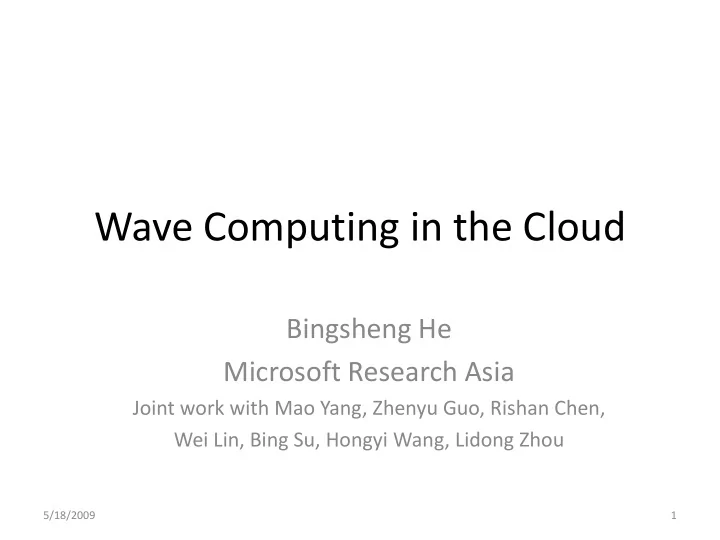

Wave Computing in the Cloud Bingsheng He Microsoft Research Asia Joint work with Mao Yang, Zhenyu Guo, Rishan Chen, Wei Lin, Bing Su, Hongyi Wang, Lidong Zhou 5/18/2009 1
My Dream Wave Computing 5/18/2009 2
But, Today, Wave Computing is Actually… The Wave model is a new paradigm for cloud computing. 5/18/2009 3
State-of-the-art in the Cloud - We provide scalability and fault- tolerance on thousands of machines. - We provide the query interference using high level languages. (MapReduce and its brothers: G . Y . M . ) 5/18/2009 4
Are G.Y.M.’s Executions Optimal? - We looked at a query trace from a production system (20 thousand queries, 29 million machine hours). - We focused on the I/O and computation efficiency. (Mr. Leopard) 5/18/2009 5
Our Finding: “Far From Ideal” Redudant I/O on 33% input data Distinct I/O 1 Normalized Total I/O 67% 0.8 46% 0.6 0.4 0.2 0 Common Current Ideal System computation 30% Production steps System Other (Results from simulation) 70% computation steps 5/18/2009 6
I/O Redundancy • Two sample workloads – Obtaining the top ten hottest Chinese pages daily – Obtaining the top ten hottest English pages daily Extract Extract Extract Filter: Filter: Filter: Filter: “Chinese” “English” “Chinese” “English” Compute Top Compute Top Compute Top Compute Top Ten Ten Ten Ten Output Output Output Output Ideal system Current system 5/18/2009 7
Computation Redundancy • Two sample workloads – Obtaining the top ten hottest Chinese pages daily – Obtaining the top ten hottest Chinese pages weekly Every day: Every week: Extract Extract Common computation on per-day log (Ideally) Filter: Filter: “Chinese” “Chinese” Compute Top Compute Top Ten Ten 5/18/2009 8
Why? Correlations among queries – Temporal correlations among queries (A series of queries with recurrent computation) 2% Recurring queries Non- recurring 98% queries 5/18/2009 9
Why? Correlations among queries – Spatial correlations among queries (Input data are targeted by multiple individual queries) Accesses to top ten 25% files Accesses to other 75% files 5/18/2009 10
How To Exploit the Correlations? Err… This is a little tricky. What about developing these? - a probabilistic model on scheduling the input data access - a predictive cache server - a speculative query decomposer. (G.Y.M.) No… Let’s K.I.S.S.: - Since correlations are inherent, we need a notion to capture them. - Our solution is the Wave model to capture the correlation for both the user and the system. (Mr. Leopard) 5/18/2009 11
The Wave Model • Key concepts capturing the correlation among queries – Data: not a static file, but a stream with periodically updated ( append-only ) – Query: computation on the input stream – Query series: recurrent computation on the stream 5/18/2009 12
Optimization Opportunities in Waves • Shared scan – Identifies the same input stream accesses among queries • Shared computation – Identifies common computation steps among queries • Query decomposition – Decomposes a query into a series of smaller queries – Uncovers more opportunities for shared scan and computation 5/18/2009 13
Query Optimizations in Wave Computing a jumbo query Series 1 • Decomposition (daily) • Form jumbo queries Series 2 • Optimizations on jumbo queries (daily) • Shared scan and computation Series 3 (weekly) 1 2 3 4 5 6 7 8 9 Query series 1: Obtaining the top ten hottest Chinese pages daily; Query series 2: Obtaining the top ten hottest English pages daily; Query series 3: Obtaining the top ten hottest Chinese pages weekly; 14
Ultimate (Wave+Cloud) Individual query series + Time = Jumbo queries 5/18/2009 15
Comet: Integration into DryadLINQ Translation: query to logical representation (expression tree) Query normalization Transformation: logical->physical More rules; Views Cost model Encapsulation: physical->Dryad Shared execution graph scan/partitioning Code generation 16
An Example of Query Decomposition in DryadLINQ Decompose an operator Q seven daily queries + one combining query Daily query Views (Cost estimation) Combining Combine all the views Automatic query decomposition is challenging. 5/18/2009 17
Micro Benchmark • Overall effectiveness – Logical optimization of Comet reduces 12.3% of total I/O. – Full (Logical + Physical optimizations) of Comet reduces 42.3% of total I/O. 200 180 Original Logical Full 160 Total I/O (GB) 140 120 100 80 60 40 20 0 1 2 3 4 5 6 7 Day (Running three sample queries on one week data of around 120 GB; 18 A cluster of 40 machine)
Summary • The Wave model is a new paradigm for capturing the query correlations in the cloud. • The Wave model enables significant opportunities in improving performance and resource utilization. • Comet: our ongoing project integrating Wave computing into DryadLINQ. 5/18/2009 19
Recommend
More recommend